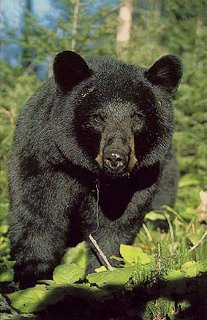
Image: Black Bear (Ursus americanus) courtesy of the National Park Service
With spring on its way bringing more people to our beautiful Blue Ridge Mountains to camp and hike, I thought that I would do a series on the black bear and how to camp and hike safely in black bear country.
This first segment is meant to familiarize you with the black bear; a little history, their look, range, and habits.
The North American black bear (Ursus americanus) is the best known and most widespread of North American bears. It is of medium size among bears, averaging 135 to 350 pounds, although individuals over 600 pounds have been found. Adult black bears, standing slightly over three feet at the shoulders, have a predominately black coat which is smooth and short haired, compared to the brown bears. However, there are also a number of well defined color variants: chocolate-brown, cinnamon and a silver gray tending to off-white. Smaller than their cousins, the black bear is an agile climber, even in adulthood. Black bears are alert creatures, with a sense of smell more highly developed than other large animals, with exceptional hearing but apparently only average eyesight.
The black bear originally inhabited the vast majority of our North American forest. Their numbers are estimated to have been about two million in the 1500's, but the black bear has been eliminated from many areas of the eastern, southeastern and central United States, and now, less than 200,000 are estimated to exist. Much of the range of the black bears is shared with the grizzly in parts of the northern Rockies, western Canada and Alaska. Although somewhat similar in coloration, in much of its habitat, the black bear does not have the noticeable front shoulder hump of the grizzly. The black bear has not been eliminated to the extent that the majestic grizzly bear has and is still found in a majority of the states, as well as all of the Canadian provinces and territories. It is a typical woodland animal and prefers forests with abundant undergrowth.
The black bear has become known to the public at large through the enormous popularity of US National Parks. As they are protected within the boundaries of the parks, some bears have lost their fear of man and will even go so far as to beg for handouts at the roadside. Other bears congregate around trash dumps or campsites and seize available food. Scarcity or abundance of natural food has much to do with black bear behavior. Not only will a black bear eat almost anything, it will gorge itself until its stomach can hold no more, sleep it off, and start the process over again.
Black bears are solitary animals that wander all their lives in search of food. The black bear's diet is similar to that of the brown bears, omnivores who will eat almost anything, but it is more markedly herbivorous. Depending on the season and the environment, vegetative matter makes up between 80% and 95% of its diet. During the spring (April-May) black bears feed mainly on grasses. Appearing to wander aimlessly, black bears are always in search of a more plentiful source of food or a mate during breeding season. In June they add insects, grubs and ants to their diet and in the fall the main source of foods are berries, mushrooms and acorns with supplemental carrion when available. Fall is a critical period as far as nutrition is concerned, in that sufficient reserves of fat must be built up for the winter. This is particularly important for those females which are going to be suckling young during the winter retreat.
Please, when you go into our forest and National Parks leave nothing but footprints and take nothing but photos and wonderful memories!
All of us here at the Blue Ridge Gazette appreciate all of our readers very much and we hope you continue to visit us and continue tell your friends…Thanks!
Technorati Tags: [Blue Ridge][National Park Service][Black Bear][Mountains][camping][hiking][North American][Rockies][Canada][Alaska][United States][US National Parks]
No comments:
Post a Comment